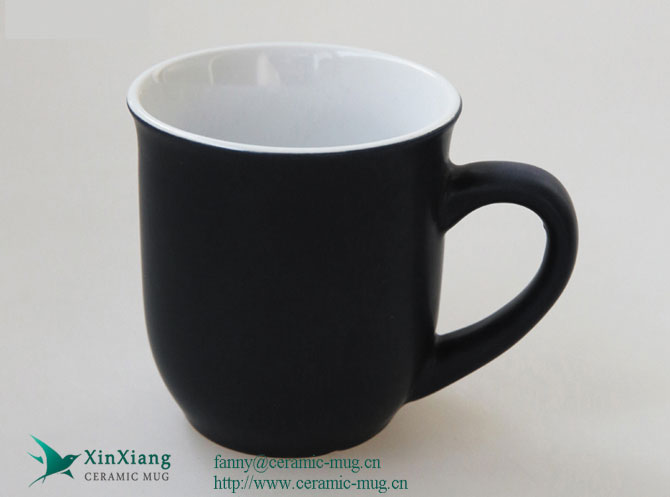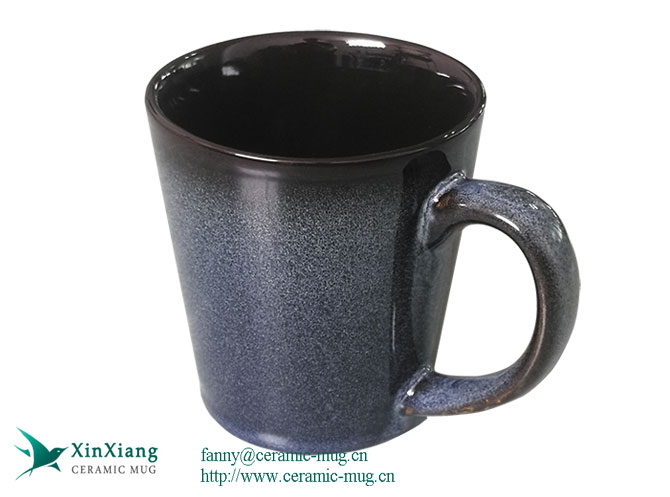|
|
|
 |
Now : Home > Ceramic Mug News |
|
|
The characteristics and functions of 7 glazes of ceramic mugs |
| Ceramic Mug From:Xinxiang Ceramic Mug Manufacturers 2023-8-24 |
|
Xinxiang Ceramic Mug Manufacturer Co.,Ltd, The glaze of ceramic products (ceramic mugs) can be divided into transparent glaze, opacity glaze, color glaze, glossy glaze, matte glaze, cracked glaze (open piece), crystallized glaze according to the appearance characteristics.
1. Transparent glaze
Transparent glaze is also called clear glaze, which is mainly made of natural raw materials such as feldspar, quartz, limestone and kaolin. The clear glaze does not have the function of covering the bottom, and the color of the body itself can be reflected through the glaze layer. This kind of glaze is characterized by low cost, simple process, easy manufacture, wide firing range and stable performance. Apply on the surface of the object, and form a smooth film after drying, showing the original texture of the object surface.
The role of green glaze
Clear glaze is a colorless or colored glassy thin layer covering the surface of ceramic products. It is made of mineral raw materials (feldspar, quartz, talc, kaolin, etc.) and raw materials in a certain proportion (some raw materials can be made into frits first) After being ground to make a glaze slurry, it is applied on the surface of the green body and calcined at a certain temperature.Xinxiang ceramic factory thinks It can increase the mechanical strength, thermal stability and dielectric strength of the product, and it also has the characteristics of beautifying utensils, being easy to wipe and cleaning, and not being corroded by dust and filth.

2. Opacity glaze
Opacity glaze: also known as "covered glaze". An opaque, glass-like coating on a ceramic body that conceals the color and defects of the body. It is formed by adding an opacifying agent to ordinary transparent glaze. In addition, opacification can also be formed when there are a large number of fine air bubbles in the glaze layer. The opacity of traditional blue glaze is mainly due to this gas-phase opacification.
The role of opacity glaze
The reason for the opacification effect is caused by light scattering. The greater the difference in refractive index between the two, the higher the degree of opacification. Commonly used opacifiers are zircon, tin dioxide, titanium dioxide, ceria, zirconia, etc. Among them, zircon is rich in resources and low in cost. The opacification can also be separated by the glass phase of the glaze layer, that is, one is the basic glass, and the other is the dispersed glass phase particles. The chemical composition and refractive index of the two are different, and light scattering can also cause opacification. , known as "opalescence". When the glaze layer contains a large number of fine air bubbles, opacity can also be formed. The opacity of celadon glaze in ancient porcelain is mainly due to this gas phase opacification.
3. Color glaze
Color glaze: Add some kind of oxidized metal to the glaze, and after firing, it will show a certain inherent color, so it is called "color glaze". Different metal oxides are added to the glaze as coloring agents, and when fired at a certain temperature and temperature, glazes of different colors will appear and become colored glazes. Traditional color glazes include: blue glaze with iron as colorant; red glaze with copper as colorant; blue glaze with cobalt as colorant. In history, there are outstanding masterpieces of color glazes in many eras, such as green glaze and Junhong in Song Dynasty, Jihong in Ming Dynasty, Langyaohong, Wujin glaze and tea powder glaze in Qing Dynasty. The difference between color glaze and ordinary color glaze lies in the special firing process and formula of color glaze. The glaze surface of the color glaze must be calcined at a high temperature of over 1250 degrees Celsius to show its unique charm of radiant oil, rainbow color, and flowing clouds and waterfalls. Colored glaze Ceramic coffee mugs are the most common.
Classification of color glaze
There are three ways to classify color glazes: one is to classify them according to firing temperature, which can be divided into high temperature color glazes (about 1300 degrees), medium temperature color glazes (about 1200 degrees) and low temperature color glazes (about 1000 degrees). If 1250 degrees is used as the boundary, it can be divided into two types: high and low; second, it can be divided into two types: oxidized flame color glaze and reduced flame color glaze according to the flame properties after firing; third, it can be classified according to the appearance characteristics after firing. It is monochrome glaze, multi-color glaze (flower glaze), crackle glaze, matte glaze, crystalline glaze and so on. There are many kinds of high-temperature colors, nearly a hundred of them with names, which can be divided into the following systems: the red glaze system includes sacrificial red, Jun red, Langyao red, glaze red, beauty drunk, etc., mainly based on copper. Colorant. The green glaze system includes Tianqing, Longquan, Douqing, Yingqing, etc., mainly using iron as the colorant. The blue glaze system includes ji blue, enamel blue, ji blue, etc., mainly using cobalt as the colorant.

4. Glossy glaze
Glossy glaze: also known as ordinary glaze. Just the opposite of matte glaze, it is our most common glaze. This glaze goes through the glazing process and firing. Attached to the surface of the embryo body, forming a protective film. Its appearance reflects light strongly and is brighter. Ceramic products can increase the mechanical strength, thermal stability and dielectric strength of the products, and also have the characteristics of beautifying utensils, being easy to wipe and cleaning, and not being corroded by dust and filth.
5. Matte glaze
Matte glaze: also known as "bright glaze". It is a kind of glaze specially made for some occasions to prevent floating light stimulation without glass light on the surface. Can be made into a variety of colors, or imitate copper, iron, wood and so on. The production methods include reducing the firing temperature to make it incompletely melted, forming orange peel, wrinkles or silky patterns on the surface; increasing the emulsifier to reduce the silicon content; artificially treating with hydrofluoric acid, etc.
Matte glaze is a kind of microcrystalline glaze, and the precipitated crystals in the glaze are generally invisible to the naked eye. Matte glaze is not absolutely without light, but compared with ordinary glaze, the finish is poorer. Generally speaking, matte glazes do not have the ordinary glass-like luster, but still have a luster similar to silk threads. Instantaneous crystallization of this glaze occurs during melting or during slow cooling. The same glaze that becomes a matte glaze when cooled slowly becomes a glossy glaze when cooled rapidly. A good matte glaze should have a smooth finish that is pleasant to the touch and easy to clean.

6. Open slice (ice crack)
Ice crack", also known as open piece, also known as broken pattern porcelain, is a variety of ancient Longquan celadon. As a special decoration of porcelain, Ge kiln products in Song Dynasty are the most famous. Among the various glaze cracks of Ge Kiln, "ice crack" ranks first, known as "Ge Kiln's character, the pattern is based on ice crack". Because of its unique cracking during the firing process, it shows infinite natural beauty. It is a pity that the craft of firing "ice cracks" was lost after the Song Dynasty. Because it is lost, and because there are very few real objects. Therefore, restoring celadon ice cracks has become a thousand-year mystery. Ice cracked ceramic coffee mugs are similar to this.
Main features of ice cracks
A natural cracking phenomenon in the glaze of porcelain. There are two reasons for cracking: one is that the mud mud extends along a certain direction during molding, which affects the arrangement of molecules. The second is that the expansion coefficients of the blank and the glaze are different, and the shrinkage rate of the glaze layer is large when it is cooled after firing. It was originally a shortcoming in the firing of porcelain, but people intentionally use the law of cracking to make split glazes. There are two types of split glazes: one is the filling type, which fills the cracks of the fired glaze with soot, etc. The lines are black; the cracks can also be filled with coloring agents such as copper sulfate, showing brown-green lines. The other is the covering type, in which a layer of color glaze is covered on the fired bottom glaze, and then fired again to show cracks and reveal the color of the bottom glaze. According to the density of cracks and different patterns, the cracks are called ice cracks, roe lines, rubbish pieces, crab claw lines, cow hair lines and eel blood lines, etc. Counting nine winters, freezing three feet, hitting it with a mallet or a stone, the ice surface will slam, and there will be many white lines that explode, which are called ice cracks.

7. Crystal glaze
During the firing process of the product, because the glaze contains a sufficient amount of crystalline substances (melt), it is in a saturated state after melting, and crystallization is formed during the slow cooling process. It is a highly decorative artistic glaze, which originated from the color glaze in ancient my country. The fundamental feature that distinguishes crystalline glaze from ordinary glaze is that the glaze contains a certain amount of visible crystals (that is, the crystal flowers on or in the glaze that we can see).
Classification of crystal glaze
There are many types of crystal glazes, and there are many classification methods.
According to the crystal shape, it can be divided into crystals such as Tianmu, raindrop, tea powder, rust flower, chrysanthemum, radial, strip, spray, star, pine needle, spiral, star, granular, water chestnut, feather, etc. glaze.
According to product classification, it can be divided into display ceramic crystal glaze, architectural ceramic crystal glaze and daily ceramic crystal glaze.
According to the glaze processing method, it can be divided into raw material crystal glaze and frit crystal glaze.
According to the firing temperature, it can be divided into high temperature, medium and low temperature crystalline glaze.
According to the crystal size, it can be divided into two categories: coarse crystal glaze and micro crystal glaze.
|
Previous : Advantages of colored glaze mugs And types and process of gl
Next : Introducing New Stainless Steel Insulated Travel Mug and Tum |
|
|
|

